Traditional Chinese 醬油 Literal meaning "sauce oil" Wade–Giles chiangyu | Simplified Chinese 酱油 Hanyu Pinyin IPA [tɕjâŋ.jǒu] | |
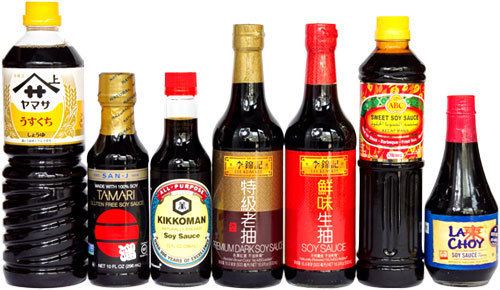 | ||
Similar Table salt, Soybean, Garlic, Ginger, Welsh onion | ||
Soy sauce (also called soya sauce) is a condiment made from a fermented paste of boiled soybeans, roasted grain, brine, and Aspergillus oryzae or Aspergillus sojae molds. Soy sauce in its current form seems to have begun in the 2nd century AD in China and spread throughout East and Southeast Asia where it is used in cooking and as a condiment.
Contents
- Sweet soy sauce
- History
- Production
- Traditional
- Acid hydrolyzed vegetable protein
- Variations by country
- Burmese
- Chinese
- Brewed
- Blended
- Filipino
- Hawaiian
- Indonesian
- Japanese
- Varieties
- Korean
- Hansik ganjang
- Gaeryang ganjang
- Other
- Malaysian and Singaporean
- Taiwanese
- Thai
- Vietnamese
- Nutrition
- Carcinogens
- Allergies
- References
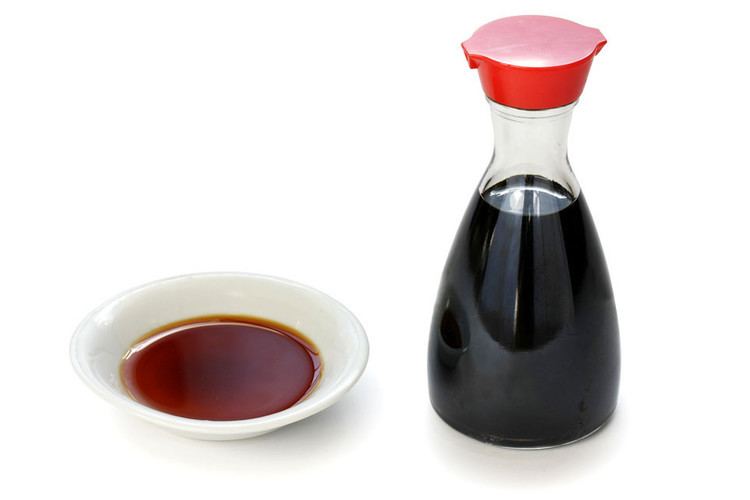
Sweet soy sauce
History
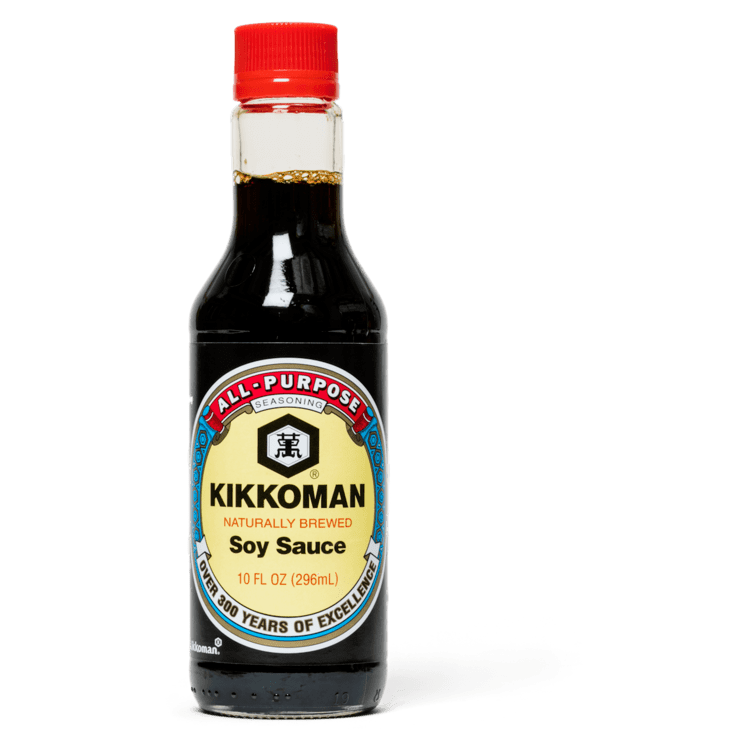
Soy sauce originated in China sometime between the 3rd and 5th century from a meat-based fermented sauce named jiang (醬). Its use later spread to East and Southeast Asia. Like many salty condiments, soy sauce was originally a way to stretch salt, historically an expensive commodity. In ancient China, fermented fish with salt was used as a condiment in which soybeans were included during the fermentation process. Eventually, this was replaced and the recipe for soy sauce, (醬油), using soybeans as the principal ingredient, with fermented fish-based sauces developing separately into fish sauce.
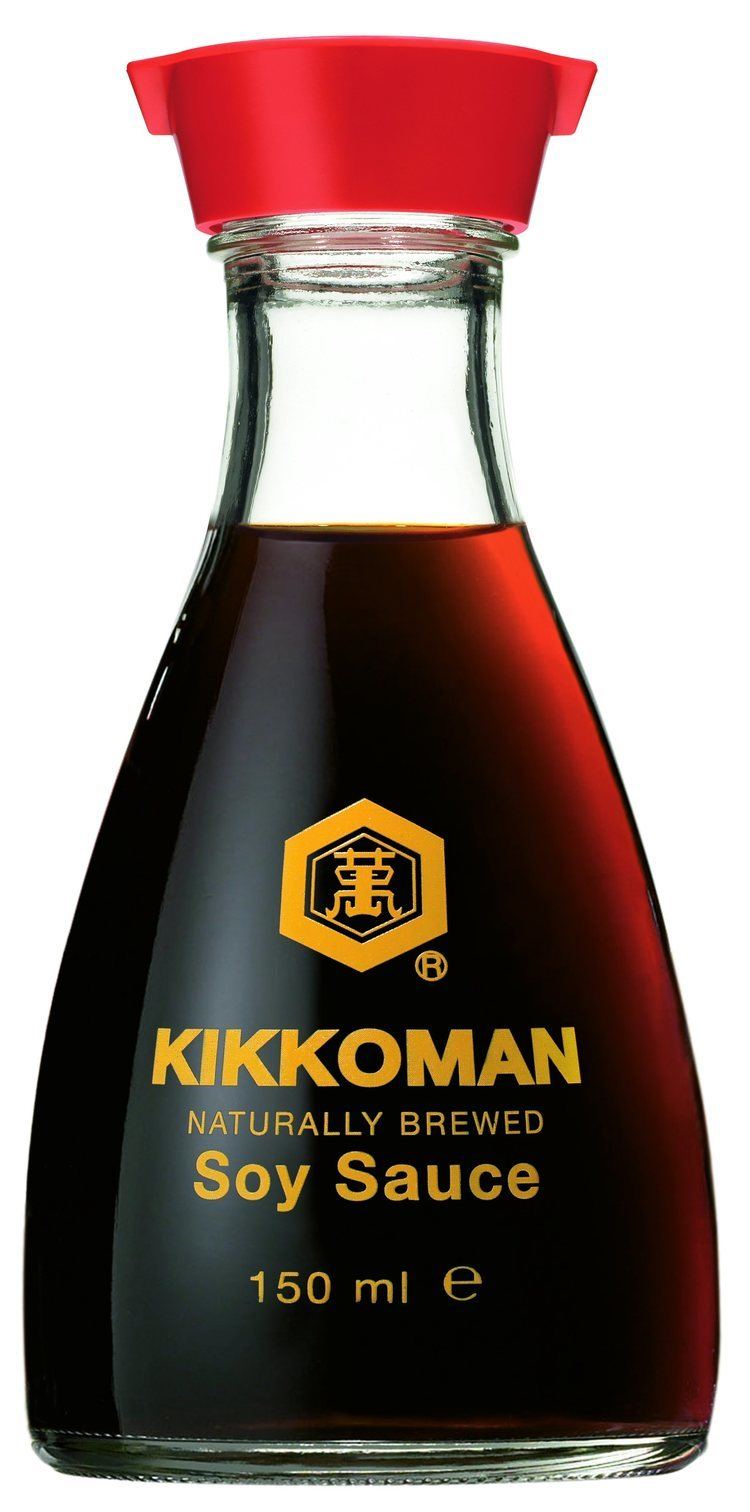
Records of the Dutch East India Company list soy sauce as a commodity in 1737, when seventy-five large barrels were shipped from Dejima, Japan, to Batavia (present-day Jakarta) on the island of Java. Thirty-five barrels from that shipment were then shipped to the Netherlands. In the 18th century, diplomat and scholar Isaac Titsingh published accounts of brewing soy sauce. Although earlier descriptions of soy sauce had been disseminated in the West, his was among the earliest to focus specifically on the brewing of the Japanese version. By the mid-19th century, Japanese soy sauce gradually disappeared from the European market, and the condiment became synonymous with the Chinese product. Europeans were unable to make soy sauce because they did not understand the function of Aspergillus oryzae, the fungus used in its brewing. Soy sauce made from ingredients such as Portobello mushrooms were disseminated in European cookbooks during the late 18th century. A Swedish recipe for "Soija" was published in the 1770 edition of Cajsa Warg's Hjelpreda i Hushållningen för Unga Fruentimber and was flavored with allspice and mace.
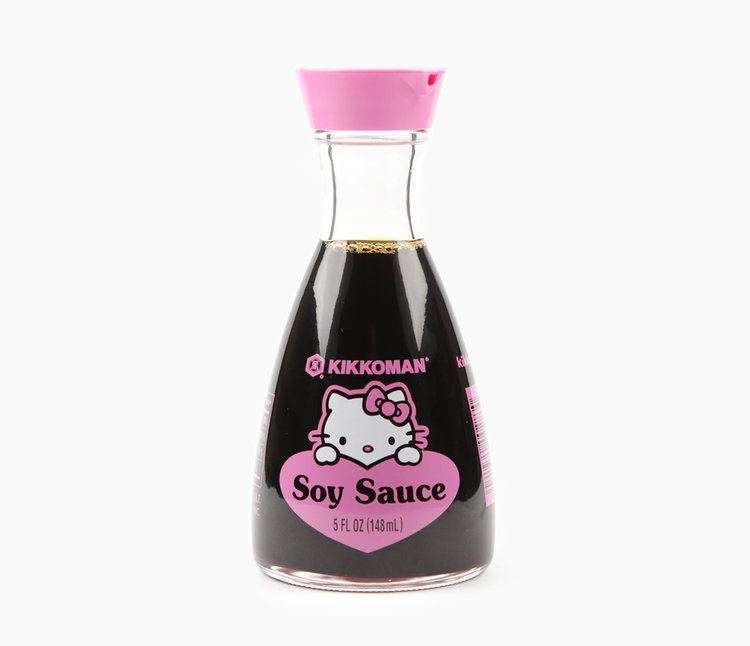
The 19th century Sinologist Samuel Wells Williams wrote that in China, the best soy sauce is "made by boiling beans soft, adding an equal quantity of wheat or barley, and leaving the mass to ferment; a portion of salt and three times as much water are afterwards put in, and the whole compound left for two or three months when the liquid is pressed and strained".
Production
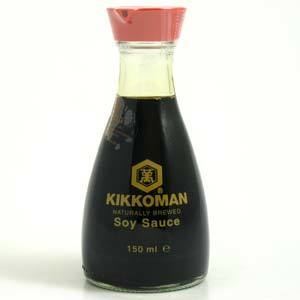
Soy sauce is made either by fermentation or by hydrolysis. Some commercial sauces have both fermented and chemical sauces.
Flavor, color, and aroma developments during production are attributed to non-enzymatic Maillard browning.
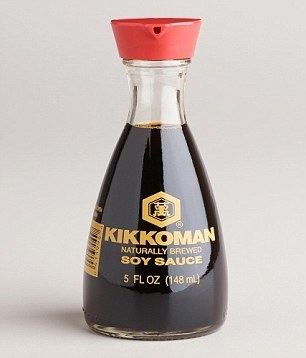
Variation is usually achieved as the result of different methods and durations of fermentation, different ratios of water, salt, and fermented soy, or through the addition of other ingredients.
Traditional
Traditional soy sauces are made by mixing soybeans and grain with mold cultures such as Aspergillus oryzae and other related microorganisms and yeasts (the resulting mixture is called "koji" in Japan; the term "koji" is used both for the mixture of soybeans, wheat, and mold as well as for the mold itself). Historically, the mixture was fermented naturally in large urns and under the sun, which was believed to contribute extra flavors. Today, the mixture is placed in a temperature and humidity controlled incubation chamber.
Traditional soy sauces take months to make:
- Soaking and cooking: The soybeans are soaked in water and boiled until cooked. Wheat is roasted, crushed.
- Koji culturing: An equal amount of boiled soybeans and roasted wheat are mixed to form a grain mixture. A culture of Aspergillus spore is added to the grain mixture and mixed or the mixture is allowed to gather spores from the environment itself. The cultures include:
- Aspergillus: a genus of fungus that is used for fermenting various ingredients (the cultures are called koji in Japanese). Three species are used for brewing soy sauce:
- A. oryzae: Strains with high proteolytic capacity are used for brewing soy sauce.
- A. sojae: This fungus also has a high proteolytic capacity.
- A. tamari: This fungus is used for brewing tamari, a variety of soy sauce.
- Saccharomyces cerevisiae: the yeasts in the culture convert some of the sugars to ethanol which can undergo secondary reactions to make other flavor compounds
- Other microbes contained in the culture:
- Bacillus spp. (genus): This organism is likely to grow soy sauce ingredients, bring to generate odors and ammonia.
- Lactobacillus species: This organism makes a lactic acid that increases the acidity in the feed.
- Brewing: The cultured grain mixture is mixed into a specific amount of salt brine for wet fermentation or with coarse salt for dry fermentation and left to brew. Over time, the Aspergillus mold on the soy and wheat break down the grain proteins into free amino acid and protein fragments and starches into simple sugars. This amino-glycosidic reaction gives soy sauce its dark brown color. Lactic acid bacteria ferments the sugars into lactic acid and yeast makes ethanol, which through aging and secondary fermentation makes numerous flavor compounds typical of soy sauce.
- Pressing: The fully fermented grain slurry is placed into cloth-lined containers and pressed to separate the solids from the liquid soy sauce. The isolated solids are used as fertilizer or fed to animals while the liquid soy sauce is processed further.
- Pasteurization: The raw soy sauce is heated to eliminate any active yeasts and molds remaining in the soy sauce and can be filtered to remove any fine particulates
- Storage: The soy sauce can be aged or directly bottled and sold.
Acid-hydrolyzed vegetable protein
Some brands of soy sauce are made from acid-hydrolyzed soy protein instead of brewed with a traditional culture. This takes about three days. Although they have a different flavor, aroma, and texture when compared to brewed soy sauces, they have a longer shelf life and are usually made for this reason. The clear plastic packets of dark sauce common with Chinese-style take-out food typically use a hydrolyzed vegetable protein formula. Some higher-quality hydrolyzed vegetable protein products with no added salt, sugar or colorings are sold as low-sodium soy sauce alternatives called "liquid aminos" in health food stores, similar to the way salt substitutes are used. These products are, however, not necessarily low in sodium.
Variations by country
Soy sauce is widely used as an important flavoring and has been integrated into the traditional cuisines of many East Asian and Southeast Asian cultures. Despite their rather similar appearance, soy sauces made in different cultures and regions are different in taste, consistency, fragrance and saltiness. Soy sauce retains its quality longer when kept away from direct sunlight.
Burmese
Burmese soy sauce production is dated back to the Bagan era in the 9th and 10th century. Scripts written in praise of pe ngan byar yay (ပဲငံပြာရည်, literally "bean fish sauce") were found. Production increased during the Konbaung dynasty, circa 1700, when there was bolstered migration of ethnic groups from the north to boost and modify the production of silk in Amarapura. Thick soy sauce is called kya nyo (ကြာညို့, from Chinese jiàngyóu.
Chinese
Chinese soy sauces (simplified Chinese: 酱油; traditional Chinese: 醬油; pinyin: jiàng yóu; Jyutping: zoeng3 jau4; Cantonese Yale: jeungyàuh; or alternatively, 豉油 ; pinyin: chǐyóu; Jyutping: si6jau4; Cantonese Yale: sihyàuh) are primarily made from soybeans, with relatively low amounts of other grains. Chinese soy sauce can be roughly split into two classes: brewed or blended.
Brewed
Soy sauce that has been brewed directly from a fermentation process using wheat, soybeans, salt, and water without additional additives.
Blended
Additives with sweet or umami (savory) tastes are sometimes added to a finished brewed soy sauce to modify its taste and texture.
Filipino
In the Philippines, soy sauce is called toyò in the native languages, derived from "Tau-yu" in Hokkien and is a broad term used for both the Japanese shōyu and Chinese jiàngyóu. Philippine soy sauce is usually a combination of soybeans, wheat, salt, and caramel color. It is thinner in texture and has a saltier taste than its Southeast Asian counterparts, similar to Japanese variety.
Toyò is used as a marinade, an ingredient in cooked dishes, and most often as a table condiment, usually alongside other sauces such as fish sauce (patís) and sugar cane vinegar (sukà). It is often mixed and served with the juice of the calamansi (× Citrofortunella microcarpa; also called calamondin, limonsito). The combination is known as toyomansî, which can be comparable to the Japanese ponzu sauce (soy sauce with yuzu). Toyò is also a main ingredient in Philippine adobo, one of the more famous dishes of Filipino cuisine.
Hawaiian
Soy sauce is a very popular condiment and marinade for many dishes in the Hawaiian cuisine. Aloha shoyu is soy sauce made in the Islands.
Indonesian
In Indonesia, soy sauce is known as kecap (old spelling: ketjap), which is a catch-all term for fermented sauces, and cognate to the English word "ketchup". The most popular type of soy sauce in Indonesian cuisine is kecap manis or sweet soy sauce. The term kecap is also used to describe other non soy-based sauces, such as kecap ikan (fish sauce) and kecap Inggris (worcestershire sauce; lit. "English sauce", due to worchestershire sauce originating in England). Three common varieties of soy-based kecap exist in Indonesian cuisine, used either as ingredients or condiments:
Japanese
Buddhist monks from China introduced soy sauce into Japan in the 7th century, where it is known as shōyu (醤油, shōyu).
Shōyu is traditionally divided into five main categories depending on differences in their ingredients and method of production. Most, but not all Japanese soy sauces include wheat as a primary ingredient, which tends to give them a slightly sweeter taste than their Chinese counterparts. They also tend towards an alcoholic sherry-like flavor, sometimes enhanced by the addition of small amounts of alcohol as a natural preservative. The widely varying flavors of these soy sauces are not always interchangeable, some recipes only call for one type or the other, much as a white wine cannot replace a red's flavor or beef stock does not make the same results as fish stock.
Some soy sauces made in the Japanese way or styled after them contain about 50% wheat.
Varieties
Newer varieties of Japanese soy sauce include:
All of these varieties are sold in the marketplace in three different grades according to how they were made:
All the varieties and grades may be sold according to three official levels of quality:
Soy sauce is also commonly known as shoyu, and less commonly shōyu, in Hawaii and Brazil.
Korean
In Korea, soy sauces or ganjang (간장, "seasoning sauce") can be roughly split into two categories: hansik ganjang (Korean-style soy sauce) and gaeryang ganjang (modernized soy sauce). The term ganjang can also refer to non soy-based salty condiments, such as eo-ganjang (fish sauce).
Hansik ganjang
Hansik ganjang (한식간장, "Korean-style soy sauce") is made entirely of fermented soybean (meju) and brine. It is a byproduct of doenjang (fermented soybean paste) production, and has a unique fermented soybean flavour. Both lighter in colour and saltier than other Korean ganjang varieties, hansik ganjang is used mainly in guk (soup) and namul (seasoned vegetable dish) in modern Korean cuisine. Common names for hansik ganjang include jaeraesik ganjang (재래식 간장, "traditional soy sauce"), Joseon-ganjang (조선간장, "Joseon soy sauce"), and guk-ganjang (국간장, "soup soy sauce"). The homebrewed variety is also called jip-ganjang (집간장, "home soy sauce").
Depending on the length of aging, hansik ganjang can be divided into three main varieties: clear, middle, and dark.
Korean Ministry of Food and Drug Safety's Food Code classifies hansik-ganjang into two categories by their ingredients.
Gaeryang ganjang
Gaeryang-ganjang (개량간장, "modernized soy sauce"), referring to varieties of soy sauces not made of meju, is now the most widely used type of soy sauce in modern Korean cuisine. The word ganjang without modifiers in bokkeum (stir-fry), jorim (braised or simmered dishes), and jjim (steamed dishes) recipes usually mean gaeryang-ganjang. Another common name of gaeryang-ganjang is jin-ganjang (진간장, "dark soy sauce"), because gaeryang-ganjang varieties are usually darker in appearance compared to traditional hansik ganjang. Having been introduced to Korea during the era of Japanese forced occupation, garyang ganjang is also called Wae-ganjang (왜간장, "Wae soy sauce").
Korean Ministry of Food and Drug Safety's Food Code classifies gaeryang-ganjang into four categories by their method of production.
Other
Malaysian and Singaporean
Malays from Malaysia, using the Malay dialect similar to Indonesian, use the word kicap for soy sauce. Kicap is traditionally of two types: kicap lemak (lit "fat/rich soy sauce") and kicap cair. Kicap lemak is similar to Indonesian kecap manis but with very much less sugar while kicap cair is the Malaysian equivalent of kecap asin.
Taiwanese
The history of soy sauce making in Taiwan can be traced back to southeastern China, in the provinces of Fujian and Guangdong. Taiwanese soy sauce is known for its black bean variant, known as black bean soy sauce (黑豆蔭油), which takes longer to make (about 6 months). Most major soy sauce makers in Taiwan make soy sauce from soybeans and wheat. Some make black bean soy sauce.
Thai
In Thailand, soy sauce is called sii-íu (Thai: ซีอิ๊ว).
Sii-íu kǎao (Thai: ซีอิ๊วขาว, "white soy sauce") is used as regular soy sauce in Thai cuisine, while sii-íu dam (Thai: ซีอิ๊วดำ, "black soy sauce") is used primarily for colour. Another darker-coloured variety, sii-íu wǎan (Thai: ซีอิ๊วหวาน, "sweet soy sauce") is used for dipping sauces. Sɔ́ɔt prung rót (Thai: ซอสปรุงรส, "seasoning sauce") is also commonly used in modern Thai cuisine.
Vietnamese
In Vietnam, Chinese-style soy sauce is called xì dầu (derived from the Cantonese name 豉油) or nước tương. The term "soy sauce" could also imply other condiments and soy bean paste with thick consistency known as tương. Both are used mostly as a seasoning or dipping sauce for a number of dishes. Vietnamese cuisine itself favors fish sauce in cooking but nước tương has a clear presence in vegetarian cooking.
Nutrition
A study by the National University of Singapore showed that Chinese dark soy sauce contains 10 times the antioxidants of red wine, and can help prevent cardiovascular diseases. Soy sauce is rich in lactic acid bacteria and of excellent anti-allergic potential.
Soy sauce does not contain the level of isoflavones associated with other soy products such as tofu or edamame. It can also be very salty, having a salt content between 14–18%. Low-sodium soy sauces are made, but it is difficult to make soy sauce without using some quantity of salt as an antimicrobial agent.
A serving of 100 ml of soy sauce contains, according to the USDA:
Carcinogens
Soy sauce may contain ethyl carbamate, a Group 2A carcinogen.
In 2001, the United Kingdom Food Standards Agency found in testing various soy sauces manufactured in mainland China, Taiwan, Hong Kong, and Thailand (made from hydrolyzed soy protein, rather than being naturally fermented) that 22% of tested samples, contained a chemical carcinogen named 3-MCPD (3-monochloropropane-1,2-diol) at levels considerably higher than those deemed safe by the EU. About two-thirds of these samples also contained a second carcinogenic chemical named 1,3-DCP (1,3-dichloropropane-2-ol) which experts advise should not be present at any levels in food. Both chemicals have the potential to cause cancer and the Agency recommended that the affected products be withdrawn from shelves and avoided. 3-MCPD and 1,3-DCP. The same carcinogens were found in soy sauces manufactured in Vietnam, causing a food scare in 2007.
In Canada, the Canadian Cancer Society writes, "Health Canada has concluded that there is no health risk to Canadians from use of available soy and oyster sauces. Because continuous lifetime exposure to high levels of 3-MCPD could pose a health risk, Health Canada has established 1.0 part per million (ppm) as a guideline for importers of these sauces, in order to reduce Canadians' long-term exposure to this chemical. This is considered to be a very safe level."
Allergies
Most varieties of soy sauce contain wheat, to which some people have a medical intolerance. However, some naturally brewed soy sauces made with wheat may be tolerated by people with a specific intolerance to gluten because gluten is not detectable in the finished product. Japanese tamari soy sauce is traditionally wheat-free, and some tamari available commercially today is wheat- and gluten-free.
